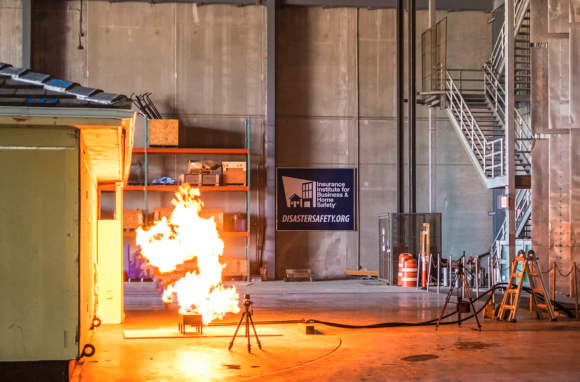Zesty.ai, a California insurtech start-up, is hoping to fine-tune fire-risk scores that sometimes can make it challenging for homeowners to find coverage.
Marketing Director Nick Allain said the company wants to help insurers who might otherwise overlook fire-resistant structures that will likely escape major damage even if they happen to be located in areas that are likely to experience wildfires.
“We know from our data that about half of the people who were denied coverage should not have been denied coverage,” he said.
Zesty has joined as an associate member the Insurance Institute for Business & Home Safety and is using IBHS research to add to its hail and fire risk models data about the resilience of landscaping and construction materials such as decking, roofing and fences. The information is combined with data about the slope of the land and the year of construction to score the building’s chances of surviving a wildfire.
Allain said the survivability test adds a second level scrutiny that underwriters can use to assess fire risk. Most insurers now use risk scores that assess risk at the ZIP-code level. They are based on U.S. Geological Survey Maps with U.S. Forest Service overlays showing vegetation levels. Allain sometimes the data dates back to the early 1990s.
Zesty’s system adds a second score that expresses the building’s ability to withstand a wildfire. Allain said some homes located in, say, a level 10 fire risk area may rank as a level 1 for survivability because they are built with fire-resistant materials, properly landscaped and equipped with modern features such as vents that deflect embers.
“Not every house burns down in wildfire,” Allain said. “When you look around neighborhoods after a wildfire, you will find some that are completely burned and some structures aren’t damaged at all.”
He said some properties have defensible space, more fire resistant materials and landscaping, and other factors that artificial intelligence can factor into a risk score.
Data on building construction is also useful when predicting the risk of hail damage. Both perils are growing sources of claims.
Bloomberg News reported that hail usually caused $8 billion to $12 billion in insured losses up until 2008, when the total jumped to $19 billion. Annual losses remained near $19 million or were higher for the next 10 years.
Wildfire was once considered an insignificant risk on the global stage, but California’s 2017 and 2018 fire seasons got noticed with a record $16 million in insured losses, according to Aon’s 2019 global risk assessment.
Allain said the IBHS data will have the most impact on Zesty’s fire risk model. Hail storms don’t generally cause complete destruction of homes, but wildfires often do, he said. A fire-survivability score can determine whether a risk is accepted.
Insurers have been skittish in California for good reason.
“A lot of insurers got 10 years of profits wiped out in two years of fires in California,” Allain said.
Allain said the IBHS data on building materials and landscaping adds a new database from which the artificial intelligence in Zesty’s system can draw to add to its risk assessment. The system also surveys city and county building permits, which was tricky because each city and county writes their reports in different ways, Allain said.
The date of construction is important, he said because newer structures will be built according to stricter standards for fire resistance.
Zesty also uses aerial imagery to discern facts about landscaping and slope. To measure slope, at least two images are needed, he said.
CoreLogic and Verisk Analytics also sell wildfire risk modeling software.
Verisk’s Fireline provides property-specific hazard scores that are based on the risk factors of fuel, slope, and access, and flags risks exposed to wind-borne embers, the company says.
CoreLogic’s system scores the wildfire risk for properties on a 5 to 100 scale based on the property’s distance to high risk vegetation, whether it is located in the “Wildland-Urban Interface,” and the surrounding area’s residential density.
Roy Wright, president and chief executive officer of IBHS, said while most of the group’s members are property and casualty insurers, the collaboration with Zesty.ai will build the role that IBHS can play for the insurance industry.
“Our deeper understanding of embers, fire behaviors and the like will inform their models that show how the physical science plays out in the real world,” Wright said. “Scaling the physical science through models will help grow and improve risk models for the insurance industry.”
Similarly, Wright said the institute’s research on hail stones — IBHS had measured, weighed and crushed more than 3,000 — will help improve risk models.
Was this article valuable?
Here are more articles you may enjoy.


 FBI Says Cybercrime Costs Rose to at Least $16 Billion in 2024
FBI Says Cybercrime Costs Rose to at Least $16 Billion in 2024  Group Sues California Department of Insurance Over FAIR Plan Surcharges
Group Sues California Department of Insurance Over FAIR Plan Surcharges  Report: Insurers Pay $1.6B in Dog Bite Claims, as Frequency Soars
Report: Insurers Pay $1.6B in Dog Bite Claims, as Frequency Soars  Uber Spends Six Figures on Ads in Latest NY Insurance Reform Push
Uber Spends Six Figures on Ads in Latest NY Insurance Reform Push 